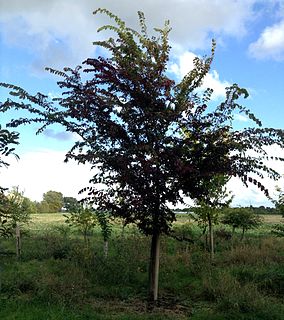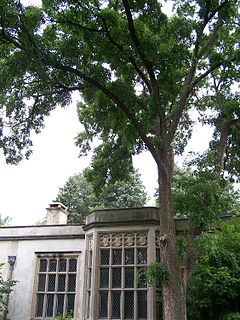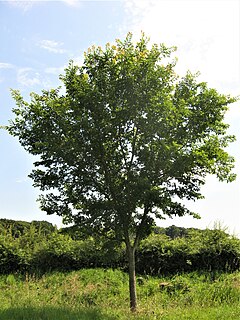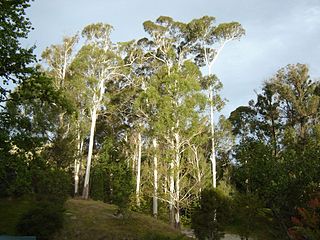Related Research Articles

An arboretum in a general sense is a botanical collection composed exclusively or very largely of trees of a variety of species. Originally mostly created as a section in a larger garden or park for specimens of mostly non-local species, many modern arboreta are in botanical gardens as living collections of woody plants and is intended at least in part for scientific study.

Ulmus laevisPall., variously known as the European white elm, fluttering elm, spreading elm, stately elm and, in the United States, the Russian elm, is a large deciduous tree native to Europe, from France northeast to southern Finland, east beyond the Urals into Kyrgyzstan and Kazakhstan, and southeast to Bulgaria and the Crimea; there are also disjunct populations in the Caucasus and Spain, the latter now considered a relict population rather than an introduction by man, and possibly the origin of the European population. U. laevis is rare in the UK, although its random distribution, together with the absence of any record of its introduction, has led at least one British authority to consider it native. NB: The epithet 'white' elm commonly used by British foresters alluded to the timber of the wych elm.

Ulmus crassifoliaNutt., the Texas cedar elm or simply cedar elm, is a deciduous tree native to south central North America, mainly in southern and eastern Texas, southern Oklahoma, Arkansas and Louisiana, with small populations in western Mississippi, southwest Tennessee and north central Florida; it also occurs in northeastern Mexico. It is the most common elm tree in Texas. The tree typically grows well in flat valley bottom areas referred to as 'Cedar Elm Flats'. The common name 'cedar elm' is derived from the trees' association with juniper trees, locally known as cedars.

The Cornell Botanic Gardens is a botanical garden located adjacent to the Cornell University campus in Ithaca, New York. The Botanic Gardens proper consist of 25 acres (10 ha) of botanical gardens and 150 acres (61 ha) of the F. R. Newman Arboretum. The greater Botanic Gardens includes 40 different nature areas around Cornell and Ithaca, covering 4,300 acres (1,700 ha).

Ulmus 'New Horizon' is an American hybrid cultivar raised by the Wisconsin Alumni Research Foundation (WARF), from a crossing of the Japanese Elm clone W43-8 = 'Reseda' with Siberian Elm clone W426 grown from seed collected from a street tree at Yankton, South Dakota. Tested in the US National Elm Trial coordinated by Colorado State University, 'New Horizon' averaged a survival rate of 74% after 10 years.'New Horizon' was patented in the US in 1994, while in Europe, it is marketed as one of the 'Resista' elms protected under EU breeders' rights.

Ulmus 'Frontier' is an American hybrid cultivar, a United States National Arboretum introduction derived from a crossing of the European Field Elm Ulmus minor with the Chinese Elm Ulmus parvifolia in 1971. Released in 1990, the tree is a rare example of the hybridization of spring- and autumn-flowering elms. Tested in the US National Elm Trial coordinated by Colorado State University, 'Frontier' averaged a survival rate of 74% after 10 years.

Ulmus 'Homestead' is an American hybrid elm cultivar raised by Alden Townsend of the United States National Arboretum at the Nursery Crops Laboratory in Delaware, Ohio. The cultivar arose from a 1970 crossing of the Siberian Elm Ulmus pumila with the hybrid N 215, the latter grown from seed sent in 1960 to the University of Wisconsin-Madison elm breeding team by Hans Heybroek of the De Dorschkamp Research Institute in the Netherlands. Tested in the US National Elm Trial coordinated by Colorado State University, 'Homestead' averaged a survival rate of 85% after 10 years. 'Homestead' was released to commerce without patent restrictions in 1984.

The hybrid elm cultivar Ulmus × hollandica 'Dampieri', one of a number of cultivars arising from the crossing of the Wych Elm U. glabra with a variety of Field Elm U. minor, is believed to have originated in continental Europe. It was marketed in Wetteren, Belgium, in 1851 as 'Orme de Dampier', then in the Low Countries in 1853, and later identified as Ulmus campestris var. nuda subvar. fastigiata DampieriHort., Vilv. by Wesmael (1862).

Ulmus 'Morton' is an elm cultivar cloned from a putative intraspecific hybrid planted at the Morton Arboretum in 1924, which itself originated as seed collected from a tree at the Arnold Arboretum in Massachusetts. Although this tree was originally identified as Ulmus crassifolia, it is now believed to have been a hybrid of the Japanese elm and Wilson's elm. Accolade has proven to be the most successful cultivar tested in the US National Elm Trial, averaging a survival rate of 92.5% overall.

Ulmus 'Morton Glossy' is a hybrid cultivar raised by the Morton Arboretum, Illinois. Originally named 'Charisma' until it was realized that name had already been registered for another plant, the tree was derived from a crossing of two other hybrid cultivars grown at the Morton: Accolade and Vanguard. Tested in the US National Elm Trial coordinated by Colorado State University, Triumph averaged a survival rate of 86% after 10 years. Triumph was introduced to the UK in 2006 by the Frank P. Matthews nursery in Worcestershire.
Norskedalen Nature and Heritage Center is a non-profit organization dedicated to the preservation of the Coulee Region's natural environment and cultural heritage. It is near Coon Valley, in La Crosse, and Vernon counties, Wisconsin, United States.

The Field Elm cultivar Ulmus minor 'Viminalis Aurea', probably a "golden" form of Ulmus minor 'Viminalis', was raised before 1866 by Egide Rosseels of Louvain, who was known to have supplied 'Viminalis'.

The elm cultivar Ulmus 'Crispa' [:'curled', the leaf margin], sometimes known as the Fernleaf Elm, arose before 1800 and was first listed by Willdenow as U. crispa (1809). Audibert listed an U. campestrisLinn. 'Crispa', orme à feuilles crépues [:'frizzy-leaved elm'], in 1817, and an Ulmus urticaefolia [:'nettle-leaved elm'] in 1832; the latter is usually taken to be a synonym. Loudon considered the tree a variety of U. montana (1838). In the 19th century, Ulmus × hollandica cultivars, as well as those of Wych Elm, were often grouped under Ulmus montana. Elwes and Henry (1913) listed 'Crispa' as a form of wych elm, but made no mention of the non-wych samara.

Ulmus minor 'Rueppellii' is a Field Elm cultivar said to have been introduced to Europe from Tashkent by the Späth nursery, Berlin. Noted in 1881 as a 'new elm', it was listed in Späth Catalogue 73, p. 124, 1888–89, and in subsequent catalogues, as Ulmus campestris Rueppelli, and later by Krüssmann as a cultivar.
The putative Wych Elm cultivar Ulmus glabra 'Dovaei', or Doué elm, was raised by the André Leroy nursery at Angers, France, as Ulmus dovaei, before 1868. The Baudriller nursery of Angers marketed it as Ulmus Dowei, "orme de Doué", suggesting a link with the royal nurseries at nearby Doué-la-Fontaine, which stocked elm. Green considered it a form of wych.

The Field Elm cultivar Ulmus minor 'Argenteo-Variegata' or simply 'Variegata', known in Australasia and North America as Silver Elm or Tartan Elm, is said to have been cultivated in France from 1772. Green noted that variegated forms of Field Elm "arise frequently, and several clones may have been known under this name". Dumont de Courset (1802) listed an U. campestris var. glabra variegata, Loudon (1838) an U. nitens var. variegata, and Wesmael (1863) an U. campestris var. nuda microphylla variegata.

Ulmus × hollandica 'Klemmer', or Flanders Elm, is probably one of a number of hybrids arising from the crossing of Wych Elm with a variety of Field Elm, making it a variety of Ulmus × hollandica. Originating in the Bruges area, it was described by Gillekens in 1891 as l'orme champêtre des Flandres in a paper which noted its local name, klemmer, and its rapid growth in an 1878–91 trial. Kew, Henry (1913), and Krüssmann (1976) listed it as an Ulmus × hollandica cultivar, though Henry noted its "similarity in some respects" to field elm Ulmus minor, while Green went as far as to regard it as "possibly U. carpinifolia" (:minor).

The 'dwarf' elm cultivar Ulmus 'Jacqueline Hillier' ('JH') is an elm of uncertain origin. It was cloned from a specimen found in a private garden in Selly Park, Birmingham, England, in 1966. The garden's owner told Hillier that it might have been introduced from outside the country by a relative. Hillier at first conjectured U. minor, as did Heybroek (2009). Identical-looking elm cultivars in Russia are labelled forms of Siberian Elm, Ulmus pumila, which is known to produce 'JH'-type long shoots. Melville considered 'JH' a hybrid cultivar from the 'Elegantissima' group of Ulmus × hollandica. Uncertainty about its parentage has led most nurserymen to list the tree simply as Ulmus 'Jacqueline Hillier'. 'JH' is not known to produce flowers and samarae, or root suckers.

Eastwoodhill is the national arboretum of New Zealand. It covers 131 hectares (1.31 km2) and is located 35 km northwest of Gisborne, in the hill country of Ngatapa. It was founded in 1910 by William Douglas Cook. Cook's life work would become the creation of a giant collection of Northern Hemisphere temperate climate zone trees in New Zealand – a dream that would eventually cost him all his money – buying and importing thousands of trees from New Zealand and British nurseries.
The field elm cultivar Ulmus minor'Viminalis Pendula', a weeping form of U. minor 'Viminalis', was first listed c.1890 as Ulmus antarctica pendulaHort., and briefly described, by the Späth nursery of Berlin, which distributed it from the late 19th century. On the continent it was also known as U. campestris antarctica pendula. Maxwell T. Masters in the Journal of the Royal Horticultural Society (1891) listed it as U. viminalis pendula.
References
- 1 2 3 Calahan, Steve (3 May 2015). "New owners have big plans for Vernon County nursery". La Crosse Tribune. Retrieved 22 August 2021.
- ↑ "Vernon couple welcomes nature, visitors". The La Crosse Tribune. 1978-09-17. p. 37. Retrieved 2021-09-09.
- ↑ "Clipped From The La Crosse Tribune". The La Crosse Tribune. 2000-05-29. p. 23. Retrieved 2021-09-09.
- ↑ "Flood cleanup continues in Vernon County". WKBT. 2016-09-30. Retrieved 2021-09-09.